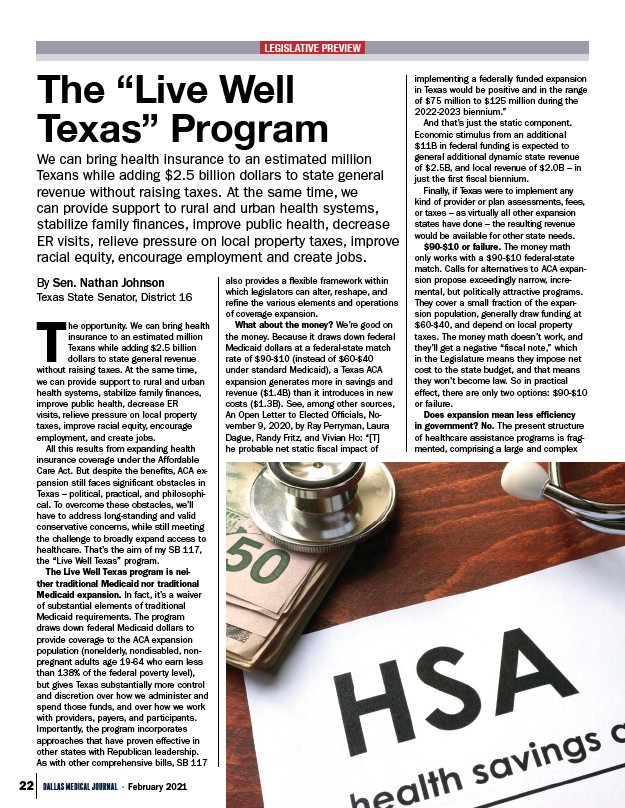
The opportunity. We can bring health
insurance to an estimated million
Texans while adding $2.5 billion
dollars to state general revenue
without raising taxes. At the same time,
we can provide support to rural and urban
health systems, stabilize family finances,
improve public health, decrease ER
visits, relieve pressure on local property
taxes, improve racial equity, encourage
employment, and create jobs.
All this results from expanding health
insurance coverage under the Affordable
Care Act. But despite the benefits, ACA expansion
still faces significant obstacles in
Texas – political, practical, and philosophical.
To overcome these obstacles, we’ll
have to address long-standing and valid
conservative concerns, while still meeting
the challenge to broadly expand access to
healthcare. That’s the aim of my SB 117,
the “Live Well Texas” program.
The Live Well Texas program is neither
traditional Medicaid nor traditional
Medicaid expansion. In fact, it’s a waiver
of substantial elements of traditional
Medicaid requirements. The program
draws down federal Medicaid dollars to
provide coverage to the ACA expansion
population (nonelderly, nondisabled, nonpregnant
adults age 19-64 who earn less
than 138% of the federal poverty level),
but gives Texas substantially more control
and discretion over how we administer and
spend those funds, and over how we work
with providers, payers, and participants.
Importantly, the program incorporates
approaches that have proven effective in
other states with Republican leadership.
As with other comprehensive bills, SB 117
22 DALLAS MEDICAL JOURNAL • February 2021
also provides a flexible framework within
which legislators can alter, reshape, and
refine the various elements and operations
of coverage expansion.
What about the money? We’re good on
the money. Because it draws down federal
Medicaid dollars at a federal-state match
rate of $90-$10 (instead of $60-$40
under standard Medicaid), a Texas ACA
expansion generates more in savings and
revenue ($1.4B) than it introduces in new
costs ($1.3B). See, among other sources,
An Open Letter to Elected Officials, November
9, 2020, by Ray Perryman, Laura
Dague, Randy Fritz, and Vivian Ho: “T
he probable net static fiscal impact of
implementing a federally funded expansion
in Texas would be positive and in the range
of $75 million to $125 million during the
2022-2023 biennium.”
And that’s just the static component.
Economic stimulus from an additional
$11B in federal funding is expected to
general additional dynamic state revenue
of $2.5B, and local revenue of $2.0B – in
just the first fiscal biennium.
Finally, if Texas were to implement any
kind of provider or plan assessments, fees,
or taxes – as virtually all other expansion
states have done – the resulting revenue
would be available for other state needs.
$90-$10 or failure. The money math
only works with a $90-$10 federal-state
match. Calls for alternatives to ACA expansion
propose exceedingly narrow, incremental,
but politically attractive programs.
They cover a small fraction of the expansion
population, generally draw funding at
$60-$40, and depend on local property
taxes. The money math doesn’t work, and
they’ll get a negative “fiscal note,” which
in the Legislature means they impose net
cost to the state budget, and that means
they won’t become law. So in practical
effect, there are only two options: $90-$10
or failure.
Does expansion mean less efficiency
in government? No. The present structure
of healthcare assistance programs is fragmented,
comprising a large and complex
LEGISLATIVE PREVIEW
The “Live Well
Texas” Program We can bring health insurance to an estimated million
Texans while adding $2.5 billion dollars to state general
revenue without raising taxes. At the same time, we
can provide support to rural and urban health systems,
stabilize family finances, improve public health, decrease
ER visits, relieve pressure on local property taxes, improve
racial equity, encourage employment and create jobs.
By Sen. Nathan Johnson
Texas State Senator, District 16